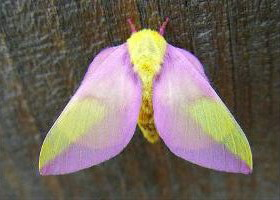The function of the conspicuous pink and yellow coloration is completely unknown. Usually boldly marked insects are toxic or distasteful to birds or mimic something that is, but as far as is known, this one is not known to be toxic and no model for such mimicry exists.
Photo Credit: Andrea Janda
Dryocampa rubicunda
Common Name: rosy maple moth
Other Common Names: green-striped maple worm
Other Scientific Names: Anisota rubicunda
Animal Guild: Insect
Class > Order > Family: Insecta > Lepidoptera > Saturniidae
What does the species look like?
The adult is almost unmistakable. A medium sized (1.25-2.3 inches) pink and yellow to white moth. The amount of pink in the outer portion of the forewing varies, but the basal third has at least some, while most of the middle third has none. The hindwing usually has some pink in the outer third. The body usually also has some pink. The only similar moth is the uncommon Hyparpax aurora, which is a bit smaller, with a small pink bar in the median part of the forewing, and the hindwings and abdomen are much whiter than the forewings. Males have much larger antennae than rosy maple moths have. Rosy maple moth caterpillars are about1.8-2.2 inches at maturity, green with paler stripes, small black tubercles, and two long thin "horns� on the front end.
Where is the species found?
States & Provinces
AL, AR, CT, DC, DE, FL, GA, IA, IL, IN, KS, KY, LA, MA, MD, ME, MI, MN, MO, MS, NC, NE, NH, NJ, NY, OH, OK, ON, PA, RI, SC, TN, TX, VA, VT, WI, WV
Distribution
This species ranges from Nova Scotia across southern Canada to southwestern Ontario, south to northeastern Texas and nearly all of Florida.
This is primarily a forest moth, but also occurs commonly in residential areas where silver maples are planted.
General Phenology and Life History
The number of annual generations is uncertain in most of the range. Adults occur from mid May into August in Nova Scotia and late April through August in New Jersey. Adults are observable through most of April and May and again from late June to September in coastal South Carolina, from March to October in southern Louisiana, and occasionally as early as January in Florida. The eggs are laid in groups on maple leaves and hatch in about two weeks. Young caterpillars occur gregariously and mature in a bit over a month. The normal foodplants are red, silver, sugar, and other maples, but caterpillars have occasionally been found on oaks in the south. Larvae occasionally become numerous enough to defoliate shade trees, especially silver maples. Pupae overwinter in the soil. Adults come readily to lights in dark rural areas, and can be seen on gas stations and convenience store walls.
Which phenophases should I observe?
Do you see/hear...?
Activity
Adults More...
For abundance, enter the number of individual animals observed in this phenophase.
Reproduction
Mating For abundance, enter the number of individual animals observed in this phenophase.
Egg laying Dryocampa rubicunda , eggs are typically deposited on the underside of maple or occasionally oak leaves.
For abundance, enter the number of individual animals observed in this phenophase.
Development
Caterpillars Dryocampa rubicunda , young caterpillars are pale yellow-green with faint green stripes along their sides and a black head. Older caterpillars are yellow-green with pale green, dark green, blue-green or black stripes along their body, a reddish-beige to bright red head, a pair of black tentacles and rows of short, black spines on their back and sides.
For abundance, enter the number of individual animals observed in this phenophase.
Caterpillars feeding Dryocampa rubicunda , caterpillars feed on the leaves of maple and occasionally oak trees.
For abundance, enter the number of individual animals observed in this phenophase.
Dead adults For abundance, enter the number of individual animals observed in this phenophase.
Dead caterpillars For abundance, enter the number of individual animals observed in this phenophase.
Method
Individuals at a light For abundance, enter the number of individual animals observed in this phenophase.
Individuals in a net For abundance, enter the number of individual animals observed in this phenophase.
Individuals in a trap For abundance, enter the number of individual animals observed in this phenophase.
What do these phenophases look like?
There is currently no photoguide available for this species. If you'd like help us create one, use the guidance document and species template provided here . Then send it via email to education@usanpn.org when it is complete.
